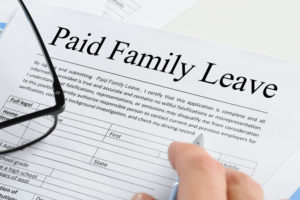The Wall Street Journal had a very good and rather comprehensive Review and Outlook piece yesterday about what’s wrong with the Democrats’ push to create a federal paid leave program.

The piece makes some important points, not least of which is that the absence in the U.S. of a federal paid leave program doesn’t mean that workers in the U.S. have no access to paid leave. In fact, although we may be the only industrialized country without a national paid leave program, we are also the only country with a vast and expanding network of companies that provide paid leave and other fringe benefits that are flexible, accommodating, and often more generous than is the program being pushed for in the Democrats’ massive $3.5 trillion bill.
In fact, in countries where government provides or mandates such benefits, the programs haven’t been delivered as promised. The WSJ notes:
We have a lot of data to confirm these problems. As I myself recently noted:
“Consider Denmark. Its government offers 52 weeks of paid leave and other generous, family-friendly benefits. But even in paradise, there’s no such thing as a free lunch. A well-cited study shows that while men’s and women’s pay grew at roughly the same rates before they had kids, mothers saw their earnings rapidly reduced by nearly 30% on average; men’s earnings were fine. Women might also become less likely to work, and if still employed, earn lower wages and work fewer hours. Women are also seriously underrepresented in managerial positions.
Some people argue that paid leave is only one side of the equation: In order to get the full benefit of paid leave, the government needs to subsidize childcare, too. This is incorrect. A recent paper looking at 50 years of data from Austria shows that the generous expansion of paid leave benefits, even when coupled with generous childcare benefits, “have had virtually no impact on gender convergence.” In other words, those claiming that the benefits are necessary to close any real or imaginary gender gaps in the workplace should find another way.”
Here is a good story about the Austria example.
One thing that government provision of paid leave is great at doing is shifting the cost of the current private programs to taxpayers, with most of the benefits going to middle and higher income workers: Here’s the WSJ reports on California’s system:
Other countries have failed too as the Heritage Foundation scholar Rachel Greszler writes:
Canada. Government paid family leave programs have exacerbated class inequality: “Despite proportionate and obligatory contributions of all employers and employees to these programs, the distribution of benefits is unbalanced and aids the social reproduction of higher-income families, especially outside of Québec.” While Quebec, which operates its own program, has taken action to increase government benefits, they “are still not equally used by mothers with lower socio-economic status.”
Norway. In Norway, which expanded paid leave to 100 percent replacement rates for nearly all mothers, researchers found that “paid maternity leave has negative redistribution properties,” and that “the extra leave benefits amounted to a pure leisure transfer, primarily to middle and upper income families.” The researchers concluded that “the generous extensions to paid leave were costly, had no measurable effect on outcomes and [also had] poor redistribution properties.”
These studies also prove that the goal of increasing access to paid leave for lower-income workers is harder to achieve than the “let the government provide paid leave” talking point suggests.
Unfortunately, there are two crucial aspects to this issue which the WSJ doesn’t address. First, it doesn’t go to the root of the confusion by debunking the idea that there’s a “failure” in the labor market that is evidenced by the fact that when workers are asked if they would like to get paid leave benefits, without ever being told at what cost they would get it, most workers say they would love to. Yet not all workers receive paid leave. This reality is no more evidence of market failure than is pointing to poll that shows that most Americans would be happy to receive a Tesla for free if given to them and calling the reality that most of these Americans do not have a Tesla a market failure.
The market is a process of exchange through which order emerges, not a static snapshot or outcome of exchange. And so the market shouldn’t be judged by comparing the outcomes of exchange at a certain point in time to the outcomes desired by policy makers or pundits. The fact is in most cases, there is simply a gap between what people think the world should look like and what the world really looks like given the necessity of making tradeoffs.
The other point ignored by the WSJ is this: Whether the provision of paid leave is private or public, over time it will reduce the wages portion of workers’ total compensation. This tradeoff is one of the reasons why not everyone gets paid leave. This point is important to understand especially for those who claim that the main reason to require paid leave is to improve the lives of workers. The adoption of a paid leave policy will only improve the lives of workers during the time that these workers value the benefit more than the cost of taking home less money as a result. This tradeoff exists whether the benefit is public or private.
This is important to understand even for those conservatives who are trying to find “more market” solutions to the lack of paid leave benefits for lower income workers. The more total compensation is paid for in the form of fringe benefits, the more they invite the left to complain that wages aren’t growing fast enough. There is no way around that.
This is not an argument against the benefit, but it is an argument against the complaint we hear coming from some conservative circles that the market is failing lower income Americans on paid leave.
Veronique de Rugy is a Senior research fellow at the Mercatus Center and syndicated columnist at Creators.


READER COMMENTS
Alan Goldhammer
Sep 23 2021 at 2:53pm
This is a well thought out post. I especially like this:
What is interesting in my suburban DC neighborhood are the significant number of men who are pushing infants in strollers during work day hours. I don’t know if they are work from home dads taking a break from Zoom or they are using paid leave from their employer.
robc
Sep 24 2021 at 12:25pm
On the one hand, total compensation, not wages, it what should be looked at.
On the other hand, counting the full value of a benefit program should only count if the employee values that benefit at that full value. If the employee is only willing to pay $500 for the benefit, counting it at $1000 is wrong.
On the gripping hand, the only way to find out how much the employee is willing to pay is to go to a full free market solution, and that isn’t going to happen anytime soon.
Todd Ramsey
Sep 24 2021 at 8:30am
Only tangentially related, but I love to vent about government penny wise, pound foolishness.
Washington state implemented a Paid Family and Medical Leave Act.
It is run by the Employment Security Department. Employers report quarterly. Paid Family and Medical Leave collects exactly the same information as the quarterly Employment Security (for Unemployment Compensation) report.
Employers are required to file two separate reports in two completely different formats. Therefore, four times per year, every employer in the state does 1-2 hours of completely unnecessary work, or pays an outside firm to do the same. Pure productivity loss. All to save the state government the few dollars it would have required to write the code, one time, to collect the information from the Employment Security report.
Perhaps related: the head of ESD who was lauded for implementing the Paid Family and Medical Leave act also oversaw the $700,000,000 loss to unemployment claim fraud in Spring 2020.
Matthias
Sep 25 2021 at 11:49pm
Even if there are arguments for a public paid parental leave programme, why would it have to be done at federal level?
What about states or even counties?
steve
Sep 26 2021 at 5:08pm
““Consider Denmark. Its government offers 52 weeks of paid leave and other generous, family-friendly benefits. But even in paradise, there’s no such thing as a free lunch. A well-cited study shows that while men’s and women’s pay grew at roughly the same rates before they had kids, mothers saw their earnings rapidly reduced by nearly 30% on average; men’s earnings were fine. Women might also become less likely to work, and if still employed, earn lower wages and work fewer hours. Women are also seriously underrepresented in managerial positions.”
Guess I am not seeing the problem here. I think this is what you should expect. The leave program only guarantees that you have access to time off. It doesnt guarantee you dont suffer consequences. A woman needs to decide between taking that full time off or taking a lot less time and trying to stay on the career track.
Steve
Comments are closed.